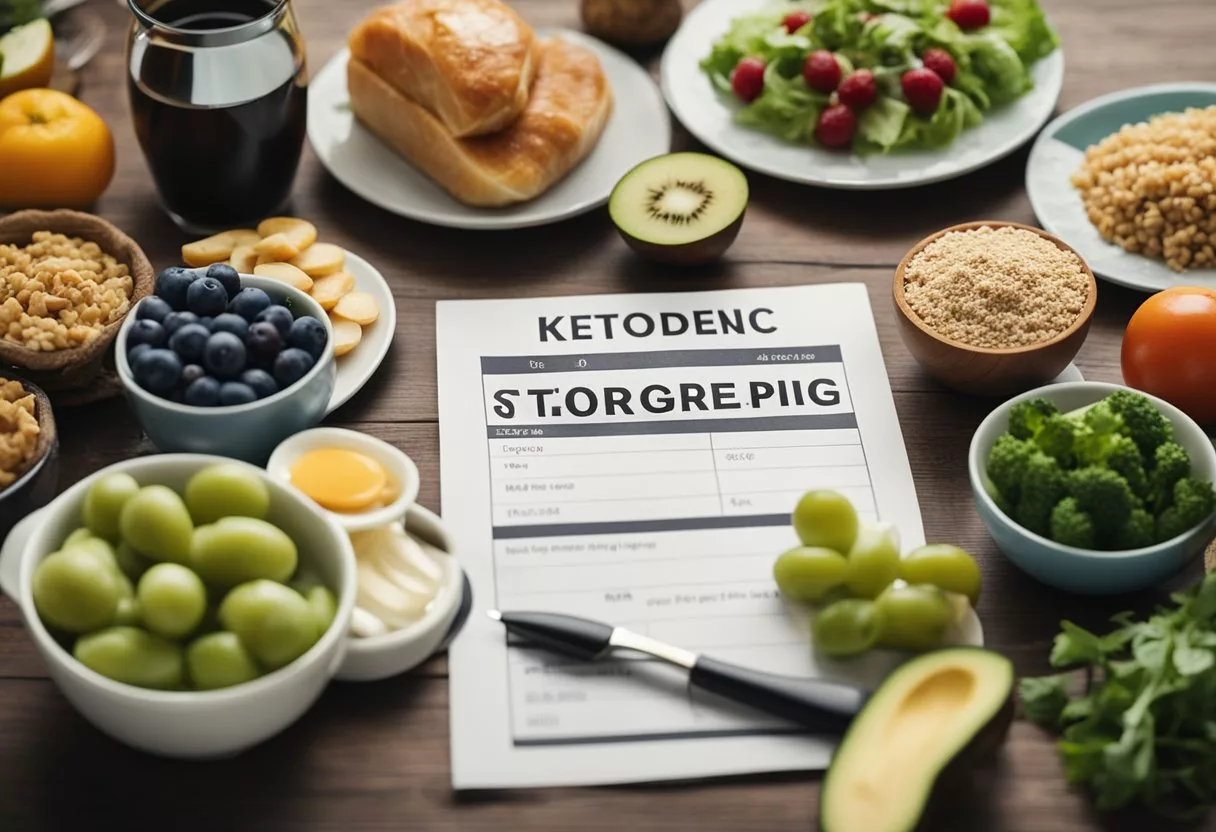Intermittent fasting and the ketogenic diet are two dietary approaches that have gained widespread popularity for their weight loss benefits. Intermittent fasting is a pattern of eating that cycles between periods of fasting and eating. It doesn’t prescribe specific foods but rather focuses on when to eat them. This method is lauded for its ability to improve metabolic health and aid in belly fat reduction by optimizing hormone levels to facilitate fat burning.

The ketogenic, or keto, diet is characterized by a significant reduction in carbohydrate intake coupled with a high fat intake, prompting the body to enter a state of ketosis. In this metabolic state, the body becomes highly efficient at burning fat for energy. Besides potential weight loss, supporters of the keto diet often report improved blood sugar control and mental clarity.
Combining intermittent fasting with a ketogenic diet may amplify these potential benefits, as both strategies can work in synergy to enhance fat oxidation and promote a caloric deficit. However, individuals considering this combined approach should be aware of their personal health status and dietary needs, as well as consult with healthcare professionals to ensure this regimen is suitable for their circumstances.
Fundamentals of Intermittent Fasting

Intermittent Fasting (IF) employs various eating patterns focused on the timing of meals to enable periods of fasting. It is associated with benefits such as blood sugar control and can modify the body’s reliance on glucose for energy.
Understanding the 16:8 Method
The 16:8 method involves a daily routine where individuals eat during an 8-hour window and fast for the remaining 16 hours. This schedule is believed to aid in blood sugar control and reduce insulin levels, as the longer fasting period may help the body switch from using glucose to using stored fat for energy.
- Eating Period: 8 hours
- Fasting Period: 16 hours
- Calorie Intake: No specific restriction during the eating window
Exploring the 5:2 Method
The 5:2 method, also known as the Fast Diet, allows for normal eating five days a week and applies calorie restriction on the other two days, reducing intake to about 500–600 calories. This intermittent fasting style can lead to a reduction in overall calorie intake and subsequently help in managing blood sugar levels.
- Normal Eating Days: 5 days a week
- Restricted Calorie Days: 2 days a week (500–600 calories)
Alternate-Day Fasting Overview
Alternate-day fasting means alternating between days of no caloric intake or significantly reduced calorie intake and days of eating normally. This method can help regulate blood sugar and may challenge the body’s hunger signals.
- Fasting Days: No or minimal caloric intake
- Eating Days: Normal caloric intake
The OMAD Pattern
One Meal A Day (OMAD) is a strict form of intermittent fasting where individuals consume all of their daily calories in a single meal. By eating once a day, usually at the same time, one may work towards better blood sugar control through prolonged fasting periods.
- Meal Plan: One meal per day
- Timing: Consistent daily mealtime
Basics of the Keto Diet

The keto diet focuses on altering the body’s main energy source from carbohydrates to fats, prompting a metabolic state known as ketosis.
Entering Ketosis
When one adopts the keto diet, their goal is to enter a state called ketosis, a metabolic process. During ketosis, the body burns fat for energy instead of carbohydrates because of the reduced intake of carbs. Typically, it takes anywhere from 2 to 7 days to enter ketosis, depending on individual metabolic rate, daily activity level, and adherence to the diet‘s strict macronutrient breakdown.
Defining a High-Fat, Low-Carb Diet
The cornerstone of the keto diet is its composition, specifically a high-fat, low-carbohydrate approach. This means consuming foods rich in fats, such as avocados, cheese, nuts, and oils, while drastically reducing carbohydrate intake to typically below 50 grams per day. This drastic reduction in carbs is necessary to deplete the body’s glucose reserves, thus encouraging the liver to start producing ketones for energy.
Understanding Macronutrient Ratios
The keto diet has a specific macronutrient ratio that comprises predominantly fat, with moderate protein and minimal carbohydrate intake. Generally, the breakdown is as follows:
- 70-80% of calories from fat
- 20-25% of calories from protein
- 5-10% of calories from carbohydrates
It is important to monitor these ratios closely to maintain ketosis. The high intake of fats and the moderate intake of proteins support muscle mass and satiety, while the low intake of carbohydrates ensures that the body uses fats as the primary energy source.
Combining Intermittent Fasting with Keto

When one adopts a ketogenic diet while intermittently fasting, they can synergize the benefits of both practices, optimize meal timing, and effectively manage their macronutrient intake.
Synergies and Benefits
A ketogenic diet typically involves high fat, moderate protein, and low carbohydrate consumption. It puts the body into a state of ketosis, where fat becomes the primary source of energy. Intermittent fasting (IF) cycles between eating and fasting periods, during which one abstains from calories altogether. The combination of a ketogenic diet and intermittent fasting can potentially lead to accelerated fat loss and improved metabolism by:
- Increasing ketone production faster: As stored carbohydrates are used during the fasting periods, the body may enter ketosis more swiftly.
- Sustained energy levels: Fats are a more consistent energy source; combining IF and a keto diet can lead to steadier energy compared to diets high in carbohydrates.
- Metabolic flexibility: This combination teaches the body to seamlessly switch between burning fats and carbohydrates for fuel.
Meal Timing Strategies
Effective meal planning can enhance the effectiveness of combining the two strategies. When structuring a meal plan, one may:
- Define a fasting window: For example, an individual might choose a 16:8 intermittent fasting plan, where they fast for 16 hours and eat during an 8-hour window.
- Align macros with eating periods: Eating high-fat, low-carb meals during the eating window to maintain a state of ketosis.
- Plan meals around activity: Consuming a higher proportion of daily calories during times of higher energy expenditure.
Managing Macros and Calories
While a ketogenic diet is focused on macronutrient ratios, intermittent fasting is concerned with meal timing and frequency. They can be effectively aligned by:
- Adjusting macronutrient ratios: Typically, a keto diet consists of about 70-80% fat, 20-25% protein, and 5-10% carbohydrates.
- Monitoring protein intake: Ensuring adequate protein to maintain muscle mass while still promoting ketosis.
- Controlling caloric intake: While in ketosis, the appetite may naturally decrease, making it easier to achieve a calorie deficit during eating windows.
It is crucial for an individual to tailor these approaches according to their lifestyle, goals, and nutritional needs.
Nutritional Guidelines

In combining intermittent fasting with a ketogenic diet, one must understand the importance of selecting keto-friendly foods and managing eating windows effectively. Careful consideration of macronutrients and fiber intake is crucial to support weight loss and health.
Selecting Keto-Friendly Foods
When embarking on a ketogenic diet, individuals should choose foods high in healthy fats and low in carbohydrates. Salmon is an excellent source of omega-3 fatty acids, and including avocados can provide nutritious fats and fiber. Olive oil is another heart-healthy fat that can be used for cooking or dressings.
- Foods to Include:
- Fatty fish like salmon
- Nuts and seeds
- Leafy greens
- Above-ground vegetables (e.g., broccoli, cauliflower)
Intermittent Fasting Food Choices
Intermittent fasting involves eating during specific time frames, which means food choices should be rich in nutrients to sustain energy levels. Prior to fasting periods, one should consume meals balanced with proteins, healthy fats, and fiber to ensure satiety and adequate nutrition.
- Foods to Eat Before Fasting:
- Lean proteins like chicken or turkey
- High-fiber vegetables
- Healthy fats for longer-lasting energy
Healthy Fats and Proteins
A ketogenic diet emphasizes a high intake of healthy fats and moderate protein. Foods like steak and eggs offer ample protein, while nuts and seeds provide additional healthy fats. These should be consumed in moderation to maintain a balance between fat and protein intake.
- Sources of Healthy Fats:
- Avocado and avocado oil
- Olive oil
- Coconut oil
- Sources of Proteins:
- Meat: Beef, pork, lamb
- Poultry: Chicken, duck, turkey
- Eggs
Understanding Net Carbs
Net carbs are calculated by subtracting fiber from the total carbohydrates, allowing for an accurate assessment of a food’s impact on ketosis. It is essential for one to monitor net carb intake to stay within the ketogenic diet’s low-carbohydrate threshold.
- Calculating Net Carbs:
- Total Carbohydrates (g) – Fiber (g) = Net Carbs (g)
Focusing on foods low in sugar and net carbs will help maintain the state of ketosis necessary for the ketogenic diet to be effective for weight loss.
Potential Health Benefits
Combining intermittent fasting and a ketogenic diet can offer a range of potential health benefits. This section delves into how these dietary strategies may interact with body processes, potentially supporting weight loss, enhancing blood sugar management, and improving mental function.
Weight Loss and Body Composition
Intermittent fasting and the keto diet may synergistically promote weight loss and improve body composition. By restricting carbohydrates, the ketogenic diet prompts the body to burn fat stores for energy, leading to ketosis. Intermittent fasting further enhances this effect by extending periods without food, which may increase fat breakdown and reduce muscle mass loss.
Blood Sugar and Insulin Resistance
These dietary approaches are observed to favorably influence blood sugar levels and insulin resistance, important factors in managing and preventing type 2 diabetes. A ketogenic diet drastically reduces carbohydrate intake, resulting in lowered blood sugar and insulin levels. Intermittent fasting may improve insulin sensitivity, which helps maintain blood sugar control.
Cognitive Function and Mental Clarity
There is growing evidence that both intermittent fasting and a ketogenic diet could support cognitive health. These benefits may be linked to improved mental clarity and a potential reduction in neurological disorders such as Alzheimer’s disease. Fasting increases ketone production, which can provide an alternative energy source for the brain and may protect against neurodegenerative diseases.
Considerations and Precautions
When combining intermittent fasting with a ketogenic diet for weight loss, individuals must consider their personal health conditions and potential risks. It is imperative to understand how special populations might be affected, the concerns specific to a keto diet, and the management of side effects and risks associated with these dietary strategies.
Intermittent Fasting for Special Populations
Intermittent fasting (IF) should be approached with caution among certain populations. Pregnant women and breastfeeding mothers may require steady nutrient intake and should avoid fasting. Similarly, individuals with diabetes may need to manage blood glucose levels more carefully, as fasting can significantly affect insulin and glycemic control. Athletes may find their performance and recovery impaired due to reduced energy availability. Those with a history of disordered eating should steer clear of IF, as it may trigger unhealthy patterns. Lastly, individuals with certain health conditions, such as cancer or epilepsy, should consult healthcare providers, as fasting can interact with treatments and the disease process.
Keto Dietary Concerns
The ketogenic diet restricts carbohydrates significantly, which can lead to a rapid loss in water weight and glycogen stores. However, this can also prompt nutrient deficiencies, particularly of fiber and certain vitamins found in fruits and grains. Individuals with heart disease or kidney function issues should be especially cautious, as the diet’s high fat intake can impact these conditions. Monitoring and adjusting fat intake is important to maintain a balance that supports health while avoiding exacerbation of existing conditions.
Managing Side Effects and Risks
Adopting intermittent fasting and a ketogenic diet may lead to side effects such as fatigue, headache, and irritability, commonly known as “keto flu“. This is typically due to the depletion of electrolytes and other adjustments the body makes when switching to fat as the primary fuel source. To minimize these risks, individuals should:
- Stay hydrated and consider supplementing with electrolytes.
- Gradually reduce carbohydrate intake instead of a sudden cut-off to ease into ketosis.
- Ensure adequate intake of micronutrient-rich foods to prevent deficiencies.
- Listen to their body and stop the diet if they experience persistent adverse effects.
Regular medical supervision is advisable to oversee the management of any pre-existing health conditions and the potential emergence of new health issues while following these dietary approaches.
Monitoring and Adapting the Regimen
When undergoing any dietary regimen, especially one that combines intermittent fasting with a ketogenic diet, it’s crucial to carefully monitor various health metrics and know when to consult professionals to tailor your plan to your body’s needs.
Tracking Progress and Outcomes
Tracking the progress and outcomes of a combined intermittent fasting and ketogenic diet approach involves monitoring key health metrics. Individuals should regularly check their body weight and blood pressure, as these are immediate indicators of how their body is responding. Keeping a detailed log of blood sugar levels can be especially important for those with diabetes or pre-diabetes. The use of spreadsheets or digital health apps may assist in organizing these data points effectively:
- Body Weight: Weekly check-ins using a consistent scale
- Blood Pressure: Bi-weekly recordings with a home monitor
- Blood Sugar Levels: Daily monitoring, preferably at the same time each day
- Ketone Levels: To confirm the body is in ketosis, if required
Encountering a plateau in body weight or a significant fluctuation in blood pressure may indicate the need for adjustments in the diet plan.
When to Consult Healthcare Providers
Individuals should regularly consult with a healthcare provider when adjusting their diet or when changes in their health metrics arise. Consultations should be sought if there is a significant and persistent increase in blood pressure or if blood sugar levels become erratic, posing a risk for worsening health conditions. A registered dietitian or a professional specializing in functional medicine may provide personalized advice to overcome plateaus or adapt the diet for long-term sustainability without compromising health.
A healthcare provider can also interpret long-term research and evidence to suggest the best course of action tailored to individual health needs. Continuous dialogue with a professional ensures the regimen remains safe, effective, and optimized for the individual’s health goals.
Preparing for Long-Term Success
Achieving long-term success with intermittent fasting and the keto diet requires meticulous planning and lifestyle adjustments. It also demands a commitment to continuous learning and community support.
Sustainable Meal Planning
For those committed to a keto and intermittent fasting regimen, devising a sustainable meal plan is essential. It’s important to curate a variety of recipes that not only adhere to the principles of ketogenic eating—high in fats and low in carbs—but also consider caloric deficits for weight loss. Incorporating a wide array of healthy foods ensures nutritional adequacy and reduces the risk of hitting a plateau.
- Meal Plan Example:
- Monday to Friday: 16/8 Intermittent Fasting Window
- Meal 1: Grilled chicken, avocado, and spinach salad with olive oil dressing
- Meal 2: Broiled salmon with asparagus and a side of cauliflower rice
- Monday to Friday: 16/8 Intermittent Fasting Window
- Weekends: Normal Keto Eating
- Meals include nutrient-dense foods with a focus on vegetables, quality protein sources, and healthy fats.
Utilizing input from a registered dietitian can help tailor the plan to individual needs and preserve muscle mass while promoting fat loss.
Lifestyle Adjustments for Maintenance
Maintaining the benefits gained from the keto and intermittent fasting combination demands comprehensive lifestyle adjustments. Exercise plays a critical role and should be consistent and varied, including both aerobic and strength training activities. Moreover, strategies for stress management and improving sleep quality contribute significantly to weight control. It’s advised that individuals engage in practices like mindfulness, meditation, or yoga to manage stress and ensure adequate sleep, cementing the foundation for lasting change.
Continuous Learning and Support
The path towards maintaining weight loss benefits from intermittent fasting and keto is not static. Long-term success hinges on an individual’s dedication to continuous learning and adapting to emerging functional medicine insights. Engaging with a community or support group provides accountability and motivation, while staying informed about the latest long-term research and randomized trials ensures that strategies are evidence-based and effective. Active participation in forums and consulting with nutrition experts can help individuals navigate challenges and refine their approach over time.
Frequently Asked Questions
This section addresses common inquiries regarding the melding of intermittent fasting and keto for weight loss, offering a detailed look at practical and health considerations.
What foods should be included in a meal plan that combines keto with intermittent fasting?
A meal plan combining keto with intermittent fasting should include high-fat, moderate-protein, and low-carbohydrate foods. Examples are leafy greens, fatty fish, avocados, eggs, nuts, seeds, and cheese.
How long should one practice a 16/8 intermittent fasting method to see weight loss results on a keto diet?
Individuals typically observe weight loss within a few weeks when consistently practicing the 16/8 intermittent fasting method alongside a keto diet. However, results may vary depending on factors like metabolism, activity level, and adherence to diet.
What are the potential risks and side effects associated with combining intermittent fasting with a ketogenic lifestyle?
Possible risks and side effects include nutrient deficiencies, keto flu symptoms, low energy levels, and hormonal imbalances. One should monitor their health closely and consider consulting a healthcare professional.
What is the expected weight loss rate when following a keto diet in conjunction with intermittent fasting?
The expected weight loss rate can differ widely among individuals. A consistent loss of 1-2 pounds per week is typical for many following this regimen, though initial rapid weight loss may occur, mainly from water weight.
How does intermittent fasting enhance the efficiency of a ketogenic diet in the process of weight loss?
Intermittent fasting may boost ketogenesis, leading to increased fat burning and accelerated weight loss on a ketogenic diet. It can also reduce overall caloric intake and improve metabolic markers.
Can intermittent fasting and keto be sustainably practiced together, and how does one create a balanced meal plan?
Intermittent fasting and keto can be sustainably practiced if one strategically plans meals to ensure adequate nutrient intake during eating windows. Balanced meal plans should include varied food sources to cover all essential nutrients.
To get your Customized Keto Diet Plan NOW, please take this quiz.
To get 3 Keto Cookbooks for FREE, go here.
